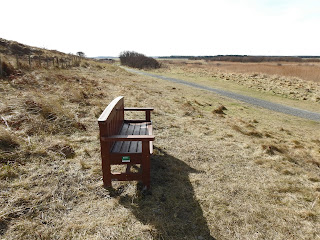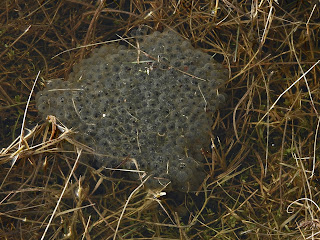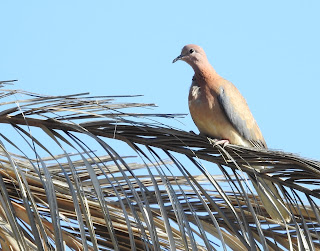Fuerteventura (Canary Islands)
20th-27th February 2018
A break from the
chilly North East was planned to include lots of casual, slow-paced birding. As
the 20th Feb, drew closer news kept arriving of more and more
birders reporting from the island with details of several rarities.
Yellow-legged Gull
Berthelot's Pipit
Day 1 The flight to Fuerteventura
was ahead of schedule and waiting for the transfer coach my very first bird of
the trip was Berthelot’s Pipit
feeding on the kerbside. As with all trips I find myself snapping birds just in
case I don’t see another. So with some suitably rubbish pictures taken I
enjoyed the coach ride to my hotel in Costa Calma (a more Northern base would
have been preferable). Bags dumped, Camera and Binoculars around the neck I
investigated the ‘green zone’ This wide belt of Palms, Australian Pines and
various shrubs running through the centre of Costa Calma would become a regular
pre breakfast and/or pre dinner stroll. Song
Thrush, Goldfinch, Blackcap and Chiffchaff
were very common. Carrion Crow (2)
and Starling (6) were unexpected.
Barbary Ground Squirrel



Day 2 Little
Bunting (2) gave brief views in the green zone before I picked up my car
for the week. I booked a 3-door Fiesta but got an Automatic 5-door SEAT Leon. No hidden price hikes and very good service
from CICAR. (Only problem I had with car was when key fob wouldn’t open the
doors, expletives rolling off the tongue until I realised I was trying to open
it with my own car keys! LOL.) My plan for the rest of the day was to head as
far South as possible and slowly work my way back North. The roads on Fuerteventura are very good. Once at Morro Jable the road
turns to a track but a very good one. I was soon at the area around Puerto de
La Cruz and headed towards Punta Pesebre. Hoopoe Larks had been reported here
earlier in the month but a short (1 hour) search proved the task of locating
them would be impossible (the downside of being anti-social). However having
seen Hoopoe Larks in the Middle East I wasn’t too disappointed, very little
sea-watching action however was. Driving back to Morro Jable and the Monk Parakeets put on a good show along
with equally tame Berthelot’s Pipit and Barbary Ground Squirrels. The reedbed
in the lighthouse reserve looked promising but offered little. A few coastal
stops were disappointing with the beach areas now at maximum disturbance with
‘holidaymakers’. A quick visit to La Pared to get my bearings for a future
visit proved highly successful with Cream-coloured
Courser (6) located on the plain very quickly and at the village itself LRP, Common Sand, Dragonflies and Trumpeter
Finches. Final bird of the day was a
Cormorant heading inland at Costa
Calma (maybe to roost in trees).

Trumpeter Finch
Spectacled Warbler
Black-winged Stilt
Hoopoe
Day 3 Pre-breakfast and the ‘green zone’ produced one
of the biggest surprises. I found the Little
Buntings (2) in exactly the same spot but feeding on the ground and with
them a Quail. I have never had such
fantastic views (heard hundreds). A twitch! Dwarf Bittern had been recorded
almost daily throughout the month at Barranco de Rio Cabras. The location had
me wondering about access so I contacted Andrew Kinghorn via Twitter (as he had
been the previous week). His knowledge was invaluable and much appreciated. He
sent me google maps for the Bittern, Tristram’s Warbler and his trip report.
The Dwarf Bittern played hard to get but the site was full of interesting
birds. Canary
Islands Stonechat
(only two males seen all week), Black-winged
Stilts, Green Sandpiper, Grey Wagtail and Buzzard. Then my first of three Egyptian Vultures did a fly past. Having walked the Barranco three
times, scrambled cliff faces along goat tracks without success I finally
spotted a couple of birders. The German guy and his Austrian girlfriend were
going to sit for the next few hours and wait patiently. After some 20 minutes of conversation I
decided to do one last walk along the cliff top (I’m not known for my
patience). I only moved 50m along and I spotted the Dwarf Bittern. Frantic shouting and waving and the couple came to
join me. It took a long time to get them on to the bird but eventually we all
enjoyed good views. One of the things we discussed was the term ‘confiding’ and
I explained what it meant. After our experience we decided it was not
‘confiding’. This may have been due to 4 off road bikers travelling along the
river bed when I first arrived. I was very happy as this was a new bird for me.
A visit to Barranco de La Torre failed to reveal any Tristram’s Warblers but Sardinian Warblers and Trumpeter Finches were numerous.
Offshore from Salinas Del Carmen feeding Sandwich
Terns and Cory’s Shearwaters
were a bonus.

Look Closely!
Dwarf Bittern
Canary Islands Chat
Sardinian Warbler
Raven

Day 4 Visited La Pared early but no sign of Coursers
or Bustards. A 4WD vehicle would give you a better chance here. Some of the
tracks in Gosney’s guide are no longer accessible. I arrived at the wet area
beneath the Golf Course at 09:30 and on cue 2 Black-bellied Sandgrouse flew to the cliff top. Over the next 20
minutes 20+ joined them but none ventured down to the water. This is a very
reliable spot but not good for getting close. I left realising (just sitting in
the car) I was stopping them from drinking. A quick drive over the plains and a
short walk (2 hours) gave me my first Lesser
Short-toed Larks and regular groups of Sandgrouse returning from their
drinking site. I was by now thinking Houbara Bustards where mythical birds (I
never believed Coursers existed until this week. I failed to see them in the
Middle East, on two trips to the Gambia
and the one on Jersey way back eluded me when
I was there.) I have tried numerous well known sites this week but none of them
were as described and auto-hide birding wasn’t possible. So the most reliable
site has to be Tindaya Plain I decide late on this visit and the time of day
wasn’t ideal but I felt if it failed I would revisit the next morning. I headed
through the village and found some really promising looking tracks. Also two
cars with birders gave me hope. I stopped to scan the area and found myself
very close to a Stone Curlew. They
are magnificent birds and my day was now on a high. Driving slowly along
various tracks this looked brilliant. After a while I decided an early return
tomorrow was a good idea and on my last scan from the car … the unmistakeable
profile of a Bustard. A very quick snap (it was miles away) and slowly I got
out of the car to put the scope on it. The heat haze was a big problem then it
started heading closer and closer snaps and video were taken. It eventually
crossed the track I was standing on! None of the classic photos everyone seems
to achieve but stunning views through the scope. After it walked out of sight I
headed along the track to find two Cream-coloured
Coursers crossing the road in front of me. As I left the village a Cattle Egret landed on the road beside
the car. Hey what, Houbara Bustard does
exist!

Lesser Short-toed Lark
Cerocala scapulosa
Cattle Egret
Spanish Sparrow
Great Grey Shrike
Corn Bunting
African Blue Tit
Kestrel
Spotted Crake
Day 5 Armed with the info from (AK) I headed back to
Rio de La Torre (I was in the totally wrong place last time.) Lots of singing
birds mainly Sardinian Warbler, Spectacled Warbler
and very surprising Lesser Whitethroats.
I may have heard Tristram’s but definitely didn’t see one. Again this was a
situation where more ears and eyes were needed. As this wasn’t meant to be a
twitching trip I am happy to leave that one for now. I then embarked on a long,
round trip of the North West.
Corn Bunting near Antigua, Blue Tit at Bentacuria and a walk to Embalse
de Las Penitas from Vega de Rio Palma
provided more surprises. Here there were some wet patches and 2m tall reed
patches. Plenty of Dragonflies, Spanish
Sparrows and Sardinian Warblers.
Then on the way back a rail/crake called
and I glimpsed some movement in the reeds. Unfortunately it headed away, so I
waited in the hope it would return. After just a few minutes a Spotted Crake walked right past me,
stunning views. Then as I walked away a frog called but I couldn’t tell where
it was. Then I reached the next reed patch and a frog called again. Several
walkers stopped to listen and I searched along the edge for the frog but no
luck and it went quiet again. The next day a group of birders at Los Molinos
asked if I had heard about the Baillon’s
Crake at Las Penitas. They had been there and heard 1 possibly 2 birds and
had seen Spotted Crake … PENNY DROPS!! That frog call was a Baillon’s Crake.
Aaaagh! An afternoon walk in the ‘green zone’ and I met the German couple and
they had had no success with buntings. I took them to see both the Little Bunting and the Quail which had moved less than 10m in
the last 3 days.


Kentish Plover
Little Stint
Desert Woodlouse?
Black Redstart
Day 6 Los Molinos holds a large amount of water and
was great for Spoonbills (4), Teal, Garganey (1), Coot and Greenshank. Another Egyptian Vulture fly by. Coastal visits
turned up a smart Black Redstart and
a Garden Warbler was new for the
‘green zone’. The beach pools at Hotel Melia Gorriones (south of Costa Calma)
were heavily disturbed by ‘holdaymakers’ but I still managed several Kentish Plovers
and a Little Stint ID from photos later. A late walk in the ‘green zone’ and
finally I found 1+ Olive-backed Pipit. Feeding on the ground they quickly flew
into the trees and out of sight. I had heard that 3 Little Buntings had been
seen earlier and when I saw 5 birds feeding on the ground I expected to see 3
Little Buntings and a couple of Olive-backed Pipits, To my surprise they were
all Little Buntings (5). Seawatching from the balcony I had
a nice passage of Cory’s Shearwaters,
Gannets and Sandwich
Terns (beats the cold cliff top watches in Northumberland).
Stone Curlew
Barbary Partridge
Houbara Bustard
Cream-coloured Courser
Day 7 My last
visit and the Olive-backed Pipits
were still in the same area but also still very elusive. Finally on approaching
the airport my last new bird of the trip Plain
Swift (4) feeding over the south end of the airport. I arrived back at Newcastle to grim weather
but lots of good birding memories.
Quail
Little Bunting
Laughing Dove
Common Sandpiper
Broad Scarlet
Delta dimidiatipenne
Kestrel
| 1 |
Berthelot's Pipit |
Anthus berthelotti |
| 2 |
Kestrel |
Falco tinninculus |
| 3 |
Collared Dove (Eurasian) |
Streptopelia decocto |
| 4 |
Collared Dove (African) |
Streptopelia roseogrisea |
| 5 |
Yellow-legged Gull |
Larus michahellis |
| 6 |
Spanish Sparrow |
Passer hispaniolensis |
| 7 |
Starling |
Sturnus vulgaris |
| 8 |
Chaffinch |
Fringlla coelebs |
| 9 |
Goldfinch |
Carduelis carduelis |
| 10 |
Linnet |
Carduelis canabina |
| 11 |
Song Thrush |
Turdus philomelos |
| 12 |
Carrion Crow |
Corvus corone |
| 13 |
Blackcap |
Sylvia atricapilla |
| 14 |
Chiffchaff |
Phylloscopus collybita |
| 15 |
Laughing Dove |
Streptopelia senegalensis |
| 16 |
Swallow |
Hirundo rustica |
| 17 |
Lesser Black-backed Gull |
Larus fuscus |
| 18 |
Raven |
Corvus corax |
| 19 |
Little Bunting |
Emberiza pusilla |
| 20 |
Robin |
Erithacus rubcula |
| 21 |
Rock Dove |
Columba livia |
| 22 |
Little Egret |
Egretta garzetta |
| 23 |
Trumpeter Finch |
Bucanetes githagineus |
| 24 |
Little Ringed Plover |
Charadrius dubius |
| 25 |
Snipe |
Gallinago gallinago |
| 26 |
Common Sandpiper |
Actitis hypoleucos |
| 27 |
Ruddy Shelduck |
Tadorna ferruginea |
| 28 |
Cream-coloured Courser |
Cursorius cursor |
| 29 |
White Wagtail |
Motacilla alba |
| 30 |
Great Grey Shrike |
Lanius excubitor |
| 31 |
Cormorant |
Phalacrocorax carbo |
| 32 |
Quail |
Coturnix coturnix |
| 33 |
Dwarf Bittern |
Ixobrychus sturmii |
| 34 |
Egyptian Vulture |
Neophron perenopterus |
| 35 |
Canary Island Chat |
Saxicola dacotiae |
| 36 |
Black-winged Stilt |
Himatopus himantopus |
| 37 |
Green Sandpiper |
Tringa ochropus |
| 38 |
Grey Wagtail |
Motacilla cinerea |
| 39 |
Buzzard |
Butteo butteo |
| 40 |
Sardinian Warbler |
Sylvia melanocephala |
| 41 |
Sandwich Tern |
Sterna sandvicensis |
| 42 |
Cory's Shearwater |
Calonectris diomedea borealis |
| 43 |
Redshank |
Tringa totanus |
| 44 |
Hoopoe |
Upupa epops |
| 45 |
Moorhen |
Gallinula chloropus |
| 46 |
Barbary Partridge |
Alectoris barbara |
| 47 |
Black-bellied Sandgrouse |
Pterocles orientalis |
| 48 |
Lesser Short-toed Lark |
Calandrella rufescens |
| 49 |
Gannet |
Morus bassanus |
| 50 |
Cattle Egret |
Bubulcus ibis |
| 51 |
Common Tern |
Sterna hirundo |
| 52 |
Lesser Whitethoat |
Sylvia curruca |
| 53 |
Corn Bunting |
Emberiza calandra |
| 54 |
African Blue Tit |
Cyanistes teneriffae (ssp ultramarinus) |
| 55 |
Spotted Crake |
Porzana porzana |
| 56 |
Grey Heron |
Ardea cinerea |
| 57 |
Kentish Plover |
Charadrius alexandrinus |
| 58 |
Black Redstart |
Phoenicurus ochruros |
| 59 |
Stone Curlew |
Burhinus oedicnemus |
| 60 |
Houbara Bustard |
Chlamydotis undulata |
| 61 |
Tufted Duck |
Aytha fuligula |
| 62 |
Teal |
Anas crecca |
| 63 |
Garganey |
Anas querquedula |
| 64 |
Spoonbill |
Plataea leucorodia |
| 65 |
Coot |
Fulica atra |
| 66 |
Greenshank |
Tringa nebularia |
| 67 |
Garden Warbler |
Sylvia borin |
| 68 |
Olive-backed Pipit |
Anthus hodgsoni |
| 69 |
Plain Swift |
Apus unicolor |
| 70 |
Little Stint |
Calidris minuta |
| |
Baillon's Crake |
Porzana pusilla |
| |
Monk Parakeet |
Myiopsitta monachus |
| |
Red-vented Bulbul |
|
| |
Feral Pigeon |
|
| |
|
|
| |
Wasp |
Delta dimidiatipenne |
| |
Broad Scarlet |
Crocothemis erythraea |
| |
Emperor Sp? |
|
| |
Moth |
Cerocala scapulosa |
| |
|
|
| |
Barbary Ground Squirrel |
|






















































































